

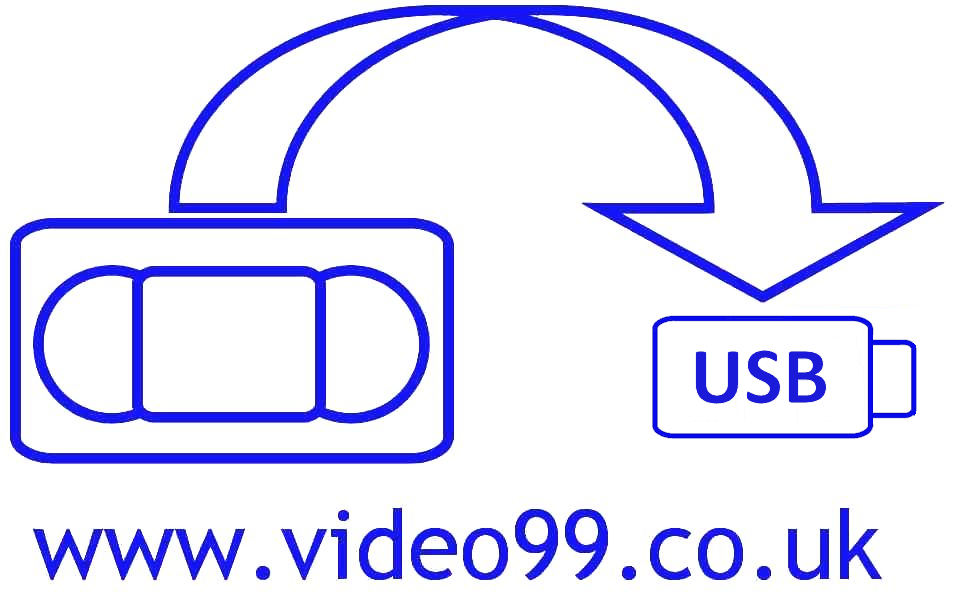 The
UK expert on Betamax to DVD transfers. Also offering transfers
of VHS, S-VHS,
Video2000,Video8, Hi8, Digital8, miniDV, Betacam, N1500, N1700 and
more: www.video99.co.uk
The
UK expert on Betamax to DVD transfers. Also offering transfers
of VHS, S-VHS,
Video2000,Video8, Hi8, Digital8, miniDV, Betacam, N1500, N1700 and
more: www.video99.co.uk Back to the late 1970's. There was a long and terrible format battle, probably the biggest ever, between VHS and Beta (known often as Betamax). VHS offered slightly longer playing time. Beta offered higher quality pictures and smaller tapes. Both formats were based on earlier designs, and hence the tapes themselves were so similar, and both appeared on the world market in 1976. When the Japanese ministry of trade saw that there was going to be a pointless format battle, they decreed that the superior format was Beta, and so the world was to adopt this. Unfortunately, JVC took no notice and carried on regardless.
We all know that VHS won the day in the end, though the battle raged on for many years. The reasons are far from obvious, it may have been that Sony were just very unlucky, and made a few poor marketing choices. For an American perspective of the causes, read Beta vs.VHS. In the UK the causes may have been different. VHS and Beta were launched here at almost the same time, and by that time Beta manufacturers also included Sanyo, Toshiba, NEC and Aiwa, as well of course as Sony.
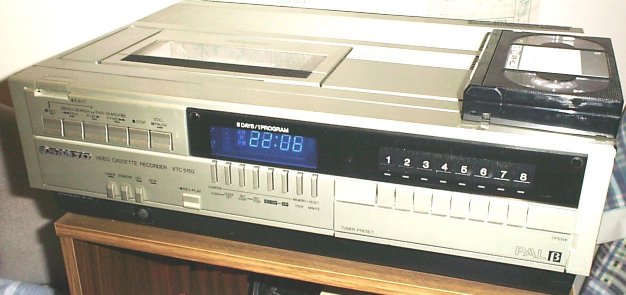 I have found the
Sanyo machines to be the most reliable, and the Sanyo
VTC5000 was UK's number 1 selling video recorder in 1983 (outselling
any
VHS model). The top loading VTC5000 and later VTC5150 had
a
lightweight and robust design, a £239 price tag, and became many
people's first
video recorder.
I have found the
Sanyo machines to be the most reliable, and the Sanyo
VTC5000 was UK's number 1 selling video recorder in 1983 (outselling
any
VHS model). The top loading VTC5000 and later VTC5150 had
a
lightweight and robust design, a £239 price tag, and became many
people's first
video recorder.
I now have a useful page
on how to service Sanyo Beta video
recorders,
fitting reel idlers and belts to them, and where to source
parts. I have
also scanned in the entire service manual (28MB download) for the Sanyo
VTC-NX100 front-loading Beta video
recorder, and this is helpful for servicing most Sanyo models, request
it if required.
But, in the days before satellite TV, lots of people rented video
films.
Furthermore, since video recorders were expensive and could be
unreliable,
lots of people rented them, too. The major rental companies were then
affiliated
with the Ferguson group, who at that time bought its machines from JVC.
So naturally,
they tended towards VHS as the preferred
format.
Added to this was the slight problem that every Sony SLC5 and SLC7 ever
built broke down due to a design fault in the rewind mechanism, which
did
not enhance the format's reputation.
 The whole VHS
vs.
Beta
debacle left consumers the worse off. Many people purchased Beta
machines since they were technically superior to VHS,
unlike in the USA the difference between VHS
and
Beta was clear for all to see on the PAL
television system. Yet, ultimately by the late 1980's they found
themselves unable to rent
a large selection of video tapes, which at that time was still an
important
reason for owning a video recorder. Beta hi-fi
stereo machines were available long before there were many sources of
material
that could be recorded on them in stereo, almost solely so that they
could
be used to enjoy top quality sound on rented movies. See the
advertising
flyer for the Sanyo VTC-M40 here.
The whole VHS
vs.
Beta
debacle left consumers the worse off. Many people purchased Beta
machines since they were technically superior to VHS,
unlike in the USA the difference between VHS
and
Beta was clear for all to see on the PAL
television system. Yet, ultimately by the late 1980's they found
themselves unable to rent
a large selection of video tapes, which at that time was still an
important
reason for owning a video recorder. Beta hi-fi
stereo machines were available long before there were many sources of
material
that could be recorded on them in stereo, almost solely so that they
could
be used to enjoy top quality sound on rented movies. See the
advertising
flyer for the Sanyo VTC-M40 here.
It is no longer possible to buy new Beta format video recorders for the UK market, and Sony discontinued production of Japanese machines at the end of 2002 due to new digital formats having replaced it in the demanding video enthusiast market. Blank Beta format tapes are still usually available via Internet sellers, see later under "Getting New Tapes". Prerecorded tapes are long gone.
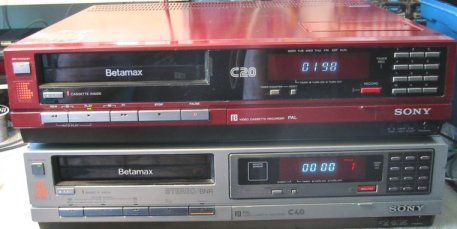 The
Sony SL-C20 and SL-C40 machines shown here are typical Beta
(Betamax branded)
domestic machines. The C20 was quite a basic model, this one
being unusual
in its red cabinet. The C40 was mechanically identical, but had
extra
features including multi-event timer, linear stereo sound with noise
reduction
and infra-red remote control. Both offered a feature called
"peep search" which allowed viewing of what was on the tape during
fast forward or rewind. Video 8/Hi8
decks
usually have this also, but very
few VHS decks do (some Sony, Philips and
Panasonic
machines emulate it) because they fully or partly unlace
during Fast Forward or Rewind operations.
The
Sony SL-C20 and SL-C40 machines shown here are typical Beta
(Betamax branded)
domestic machines. The C20 was quite a basic model, this one
being unusual
in its red cabinet. The C40 was mechanically identical, but had
extra
features including multi-event timer, linear stereo sound with noise
reduction
and infra-red remote control. Both offered a feature called
"peep search" which allowed viewing of what was on the tape during
fast forward or rewind. Video 8/Hi8
decks
usually have this also, but very
few VHS decks do (some Sony, Philips and
Panasonic
machines emulate it) because they fully or partly unlace
during Fast Forward or Rewind operations.
Some confusion exists over the name of the Beta format. Most Sony Beta machines were marketed as Betamax, most Sanyo ones were marketed as Betacord. HiFi machines from both manufacturers were called Beta HiFi, and higher performance ones as SuperBeta. Other manufacturers tended to use just the Beta name. Camcorders from Sanyo and Sony used the Betamovie name (the world's first camcorders were Beta). Why they used this myriad of names is a mystery. The Betacam format as mentioned above is not compatible with domestic machines, except that in certain instances (earlier Betacam recorders) the blank tapes could be used in either.
Most Beta machines sold in the UK were built by Sanyo, Sony or Toshiba. A few other machines such as NEC appeared, but most were "cloan" copies of models built by the main manufacturers. International brand names included Aiwa, Tensai, Universum (Quelle), Palladium, Zenith, Radio Shack, Europhon and Bush.
The name Beta (and so Sony's Betamax) was derived from the tape loading path, which is (very) vaguely like the ß symbol. VHS's tape path was typically known as M-wrap. As time went on, some VHS decks have used a loading path much more akin to the Beta system, to attempt to gain features such as "peep search" (quick shunt to picture search when performing rewind or fast forward, fitted as standard to many Beta decks) and similar tricks. The name VHS was originally intended to mean "Video by Helical Scan" but since all video formats use Helical Scan, including Beta, this was dropped in favour of "Video Home System" which is still the proper meaning today. I prefer "Very Horrible System" myself.
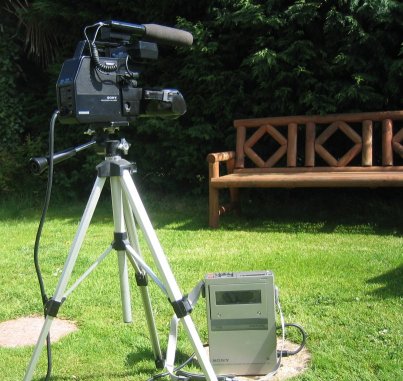
Beta stole a clear lead over VHS in the early days of
home video movies. Beta portable
equipment was smaller and often of higher
quality than the VHS equivalents.
Later Sony
invented the first combined camcorders, again using the Beta format of
course. VHS never really made up
the lost
ground, VHS tapes were bulkier so the
machines
were bulkier, and by the time the compact VHS-C
was
invented, Video 8 had arrived and very
quickly took
over the market (see later).
V2000 / Video 2000 / Video Compact Cassette
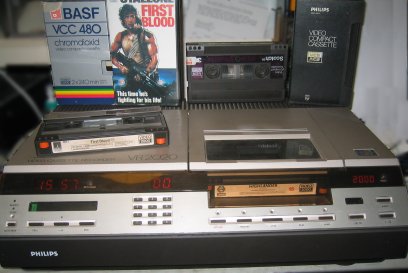 The
first V2000
video recorder sold in the UK.
The
first V2000
video recorder sold in the UK.
I have service manuals for the Philips VR2023 and VR2024 machines available, which is a 44MB file download so request it as required. There is a yahoo forum dedicated to these machines.
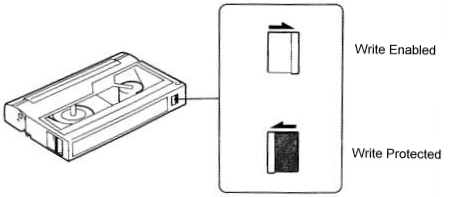 The
whole silly
thing started again when all the major players in the video field
decided
not to have another format battle when it came to camcorders. Everyone
agreed on Video 8. Then, just as Sony was
about to launch it's first Video 8
camcorder,
JVC got cold feet and decided instead to launch VHS-C.
Video
8 was a completely new format, whereas
VHS-C
tapes could (in theory at least) be played back via an adapter on a VHS
machine. However the idea didn't always work, since the VHS-C
recording
time is so short, 45 mins on PAL used in the UK, that many users had to
resort to half-speed if they were to avoid feeding the camcorder with
tapes
at inappropriate moments. Now the half speed recording may or may not
be
playable on your VHS deck, even if it
supports
half-speed, since the VHS format never
promises
the ability to play half-speed recordings successfully on another
machine.
So the hapless half-speeder has to play it back in the camcorder, like
they would have done if they had bought Video8
in the first place. To add insult to injury, when it gets copied to VHS,
they now have a half-speed VHS-VHS
copy;
virtually useless.
The
whole silly
thing started again when all the major players in the video field
decided
not to have another format battle when it came to camcorders. Everyone
agreed on Video 8. Then, just as Sony was
about to launch it's first Video 8
camcorder,
JVC got cold feet and decided instead to launch VHS-C.
Video
8 was a completely new format, whereas
VHS-C
tapes could (in theory at least) be played back via an adapter on a VHS
machine. However the idea didn't always work, since the VHS-C
recording
time is so short, 45 mins on PAL used in the UK, that many users had to
resort to half-speed if they were to avoid feeding the camcorder with
tapes
at inappropriate moments. Now the half speed recording may or may not
be
playable on your VHS deck, even if it
supports
half-speed, since the VHS format never
promises
the ability to play half-speed recordings successfully on another
machine.
So the hapless half-speeder has to play it back in the camcorder, like
they would have done if they had bought Video8
in the first place. To add insult to injury, when it gets copied to VHS,
they now have a half-speed VHS-VHS
copy;
virtually useless.
Due to the above inevitable logic, the Video 8
format won the day over VHS-C
which is
now obsolete. Blank VHS-C tapes
should
however be available for a few more years, and you might see a VHS-C
camcorder in a bargain bucket for a few tens of pounds even into
2005,
which might be a nice toy for the kids. Against VHS-C, apart from short running
time and bulky tapes, was reliability. There last two manufacturers
supporting
this format were Panasonic and JVC.
I shouldn't say this, but I will; JVC have lost it, whatever it was,
and
all JVC equipment recently suffered from shoddy construction and poor
reliability.
Panasonic, to their credit, are reliable. Both manufacturers have
seen the
error of their ways and are heavily plugging DV
camcorders now.
Hi8 and S-VHS-C
Just variations on a theme, there are high performance versions of both Video 8 and VHS-C. Most if not all of the last analogue camcorders on the market were of the Hi8 format. Since the odds are that the potential S-VHS-C camcorder owner did not own a S-VHS video recorder to play back his/her tapes (they were never very popular), then he/she would have been playing back in the camcorder. So in that case, they would have been well advised to go for Hi8 in the first place and get longer running time, and most people did. S-VHS-C never really took off and died. As well as the more demanding home users, Hi8 was widely used by roving reporters for TV companies, where the tapes small size, long running time and top quality are all great bonuses. More recently though, DV digital video took the place of Hi8 for this sort of work.
Full-sized mains S-VHS and Hi8
machines were available, at a cost. The Sony EVS9000E machines
that I
have several of, 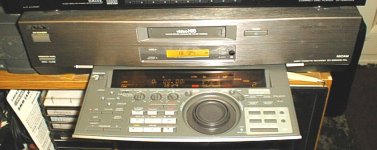 boast
time coding, full-frame digital timebase corrector, LANC edit
controller, as well as being
a normal domestic machines, the full selling price was around £1700.
It also has PCM digital stereo sound, which allows for hi-fi audio
dubbing,
perhaps the only "domestic" analogue video recorder available in the UK
that offers
this. It is quite a rare beast and in many
ways is the most sophisticated domestic analogue video tape recorder
ever sold
in the UK, since it is really a semi-professional deck with a domestic
tuner
added for home use. Let me know if you would like to review
the instruction manual, I have scanned this in.
boast
time coding, full-frame digital timebase corrector, LANC edit
controller, as well as being
a normal domestic machines, the full selling price was around £1700.
It also has PCM digital stereo sound, which allows for hi-fi audio
dubbing,
perhaps the only "domestic" analogue video recorder available in the UK
that offers
this. It is quite a rare beast and in many
ways is the most sophisticated domestic analogue video tape recorder
ever sold
in the UK, since it is really a semi-professional deck with a domestic
tuner
added for home use. Let me know if you would like to review
the instruction manual, I have scanned this in.
Sony marketed a combined VHS/Hi8 deck, and Goldstar a Hi8 (playback only) and VHS combined deck.
There is an extension of Hi8, called Digital 8. It was manufactured mainly by Sony (and previously by Hitachi), and is intended really for people who have owned Video8 or Hi8 camcorders in the past, and want to go digital. These camcorders used standard and cheap Hi8 tapes, which used to be cheaper than digital mini-DV tapes, and record in a true digital format to give results just as good as mini-DV. Most of the camcorders can also play older Video8 and Hi8 tapes, see the bottom of this page for the full list of those that do. They were useful for Video8 / Hi8 owners who want to upgrade, but are also very useful for transfers to DV-AVI files on a PC.
High Quality VHS?
HQ (for "High Quality") was a long established set of three conditions, of which two must be met, in order for a VHS machine to qualify for the HQ logo. HQ attempts to reduce the amount of video noise and improve the edge definition of VHS, two of the greatest weaknesses of the format. The HQ system was developed as an answer to SuperBeta, and used some similar technology. The improvement, though welcome, was marginal. There was one manufacturer who made a real effort to improve the VHS format, namely Akai. They built a series of machines with I-HQ, which intelligently tunes the machine's recordings to suit the performance of the tape. High grade VHS tapes or S-VHS tapes, have more of their available bandwidth used to really improve the picture quality. However Akai video recorders, or at least all the ones I have seen, were shockingly badly built, which is a real shame because the technology inside was highly innovative.
VHS was such poor quality that a recent court case had vital CCTV footage thrown out because the Australian Police had foolishly used a VHS copy rather than use original recordings from a computer. BBC news reports: "A key piece of evidence in the trial of a man accused of killing British backpacker Peter Falconio should be disregarded, the trial judge has said.... The court has heard the video was of "poor quality" and police did not seize the computer hard drive on which the original digital video images were stored. Instead, officers copied the video on to VHS tape, reducing the quality of the images further." Learn the lesson: Never use VHS!
SuperBeta
The only Beta machines made since around 1995 were of the SuperBeta type, which can record and play in standard Beta hi-fi format, or also, using the same tapes, a high performance SuperBeta format. The definition is not as high as true high band Hi8 and S-VHS decks, though I've heard of people say that the video noise is lower, so the overall impression may be as good. The top resolution of SuperBeta is called Superbeta Pro which requires high grade Pro-X tapes, which Sony no longer market.
ED Beta was a true high band format, but was never released in the UK.
BetaCam (where Beta won over VHS!)
Betacam is a professional studio video tape format derived from the domestic Beta format. There are several variants of Betacam, including Digital Betacam, and the portable machines use tapes which are exactly the same physical dimensions as a domestic Beta tape, though the running time is much shorter. Fixed machines also take much larger (and longer running) tapes in the same mechanism.
 On
the left, a professional Betacam tape, on
the right
a domestic Beta (Betamax)
tape. In this case they are virtually identical and either can be
used in
both types of equipment.
On
the left, a professional Betacam tape, on
the right
a domestic Beta (Betamax)
tape. In this case they are virtually identical and either can be
used in
both types of equipment.
I wouldn't want you to read the above and believe that TV studios use domestic Beta equipment, they don't. But pretty well every TV studio in the world uses the Betacam format to some extent, even today. When Sony invented the professional Betacam format, they wanted the ability for a roving reporter to just pop into a shop and buy a domestic Beta blank tape for their portable camera should the need arise. So the early professional Betacam equipment used tapes as the one shown on the left here, which was compatible with the domestic tapes. The real difference was that in the professional Betacam format, and 150m length tape would run for just 20 minutes, whereas in the domestic format this same tape would run for over three hours. Longer running versions of the professional Betacam format exists too, with much larger cassettes. Modern Betacam machines will accept either the larger or smaller sized tape. Further enhancements of the Betacam format have continued, and all modern Betacam equipment uses Metal Particle tapes for much higher definition using the Betacam SP format. These latter tapes will almost instantly destroy the heads of a domestic Beta video recorder, so don't even think about using them! Further enhancements are Digital Betacam and Betacam SX which are very much current technology, followed by HDCAM.
A VHS-derived professional system called M-Format and later MII, used VHS sized tapes in just the same was as Betacam uses Betamax sized tapes. Despite marginally superior performance, tbe Betacam format was too entrenched in TV studios for the MII format to succeed. I can transfer MII video tapes to DVD or computer however, along with almost any other format. This is almost an exact mirror of the domestic Beta/VHS format battle, in which the popular format won just by being popular. However of course the MII format did suffer from the VHS legacy of bulky tapes which was a real nuisance for roving reporters. For more information on Betacam , see the excellent Palsite. I now offer high quality Betcam / Betacam SP and Digital Betacam tape to DVD transfers.
Betaphiles, parts and linksBetaphiles are perfectly ordinary people who think that VHS stinks. Which it does. There's a whole bunch of people who feel this way,and you can read about them in this article. However it has a USA slant, so technically some of the descriptions may not be correct for the PAL television system. In particular, the Beta hi-fi system used in the UK is actually much more akin to the VHS hi-fi system, and early machines suffered the same hi-fi tracking problems as did early VHS hi-fi decks.
See the Beta lore discussion group, with lots of stories about people and their Beta machines, part of the Beta Palsite to which I have contributed a few pieces of information, and which gets my wholehearted recommendation. They also cover Betacam and V2000 models, and help on repairs and parts suppliers. Companies I have used recently include Grandata, CPC Farnell and Telepart/Ecomonic Devices. There is an outstanding USA website full of fascinating pictures and information about dozens of video formats. I now have a useful page on how to service Sanyo Beta video recorders, fitting reel idlers and belts to them. I must highly recommend a part of the Sony website which had an excellent museum telling the story of Beta, and also a time capsule with details on some of the models (it's a bit hard to find now). There are BBC news articles on the demise of Beta and the demise of VHS, spaced apart by only two years.
Sanyo helpfully have the instruction manuals for many of their machines on their web site.
Machines for sale
If you wish to buy or sell a Beta machine, in the UK I would recommend eBay. As for prices of good working video recorders, expect around £30-£120 for a mono or linear stereo machine, up to £350 for Beta Hifi stereo, and up to £450 for SuperBeta Hifi. Add maybe 25% for machines which have been properly serviced and are guaranteed. Front loading models fetch more than top-loaders. For non-runners, don't expect much more than the postage costs. Good TV/video repair shops are quite capable of repairing Beta video recorders, and parts for Sanyo machines tend to be easier to get than for similarly aged VHS decks. Some vital Sony parts are no longer obtainable, Sanyo parts are much easier to source, so much so that I would not really recommend buying a Sony machine unless you are prepared to try to repair it yourself with non-original parts. The Sanyo VTC5000 and VTC5150 are good solid top loaders that work forever with just a few minor service items to the reel drive for which parts are readily available, and an assortment of equally indestructible front loader models followed, probably your best bet today. I now have a useful page on how to service Sanyo Beta video recorders, fitting reel idlers and belts to them, and now supply the required parts at the best price anywhere. The Sony top loading SL-C7 is a high spec machine but was very complex and too many parts are unavailable today to be worth considering unless you can carry out your own creative repairs, whereas the simpler SL-C5 is almost as unreliable but primitive and worthless. The front loading Sony SL-C6 is heavy and lumpy but faults are fewer than the C7. Sony C20, C30, C40 (pictured above) and later models suffer from various minor problems which are made serious by a complete lack of almost all important parts today. Sony SL-F20/30/40 models are very slim, slightly more reliable than previous models, and seem to have a spectacularly good playback picture even with worn tapes.
In Japan no further units were produced beyond year 2002.
Compatibility and transferring tapes to DVD and other formats
I get a lot of emails from people asking where to buy a working Beta machine. All I can suggest is the eBay. I do very occasionally get given a machine which I service and sell, as and when this happens I will advertise it here.
I'm still getting emails from people asking if there is an adaptor
to allow Beta tapes to be played in a VHS video recorder, a
Beta to VHS adaptor.
The answer of course is no, don't be silly. The formats are
fundamentally different.
Similarly, if
Beta tape is loaded into a VHS cassette, or the other way round, you will
not be able to view the pictures
(though you may be able to record new recordings on the tape).
What is
possible of course is to plug a
Beta video recorder into a VHS or SVHS or Video8 or Hi8 or DV (etc) video recorder, and re-record the
programs onto a different tape. There is something else which
people ask
about, namely can PAL (UK TV format)
Beta tapes be played on NTSC (USA
format)
Beta machines and vice versa. The
answer is
again, no. The tapes are identical but the recording itself is
different. You may get sound running at the wrong speed, but you
will not
get a picture. The same is often true of VHS
PAL and NTSC tapes, though some later VHS
decks
are able to play both PAL and NTSC.
Top quality video tape transfers offered: For Beta, VHS, V2000, all camcorder tapes and professional studio tapes. These days I recommend video files on a USB stick or hard disk rather than transfers to DVD.
Don't risk your precious memories with any old outfit, some people just use a tired old Beta video machine and a cheap DVD recorder. See testimonials of my work on the web page, to know that the extra effort I put in really pays off. My video recorders are properly cleaned, aligned, serviced and thoroughly tested before your tapes go anywhere near them. All my transfers are done with the benefit of a full-frame Digital Timebase Corrector to stabilise the image, transfers to DVD or video files on hard disk. I've been doing Betamax to DVD copies for several years, being one of the first in the UK, and I've now extended this to other formats. As as a qualified electronic engineer with a strong consumer electronics background, I know what I'm doing.
Getting new tapes
New tapes are getting harder to locate, though I do sometimes have
some for
sale. Another possibility may be the use of low band
(oxide type) small Betacam tapes which
generally work fine, and are readily available from professional
video suppliers. I once knew of a Sony SL C9 give poor results
with these
though. If you accidentally use a High Band Betacam
SP tape (as used in TV studios), into a domestic Beta
video recorder, the result could be very destructive, the metal tape
formulation
may wear out the heads quickly. Consider the Fujifilm
H321E-20S, Sony BCT-20G or BCT-30G. Sony are finishing production
of blank Beta tapes in 2016 (probably along with VHS).
Urban myths, true or false.
The future?
I'm sorry to say that the really is no future beyond enthusiasts for Beta now, but not because VHS replaced it. VHS, Beta and Video 8, and all their analogue high band derivatives, are completely blown out of the water by a high quality Digital Video (DV) machine, and of course Sky+ and DVD recorders are very popular. Whilst Digital Video is not perfect, there can be some peculiar artifacts just as with DVD, the overall result is far superior to any analogue video recording. Those people who held the Beta video format in esteem, did so because the quality was so obviously superior to VHS. But those who need a quality video recorder now can simply use a digital recorder and enjoy something close to perfection. The professional version, Digital Betacam including HDCAM format is still used and will be used in TV studios long after VHS has been forgotten. So in one form at least, Beta outlasted VHS.
Can you help me?
Having written this for the good of the world, I would like a little help if you can. If you have a dead or unwanted Beta video recorder in the UK, I will happily pay the postage (typically less than £15 with Royal Mail Parcels) to have it sent to me, so that I can try to repair it and find a new home. In particular I like all Sanyo front loader machines, also the Sanyo VTC5000 and VTC5150, and any Sony machine from SL-C9 onwards. Unwanted V2000 format machines may be welcome too. Also, if you have any service manuals for Beta equipment which you don't need, they would also be useful to me. I can be contacted here.
 The
UK expert on Betamax to DVD transfers. Also offering transfers
of VHS, S-VHS,
Video2000,Video8, Hi8, Digital8, miniDV, Betacam, N1500, N1700 and
more: www.video99.co.uk
The
UK expert on Betamax to DVD transfers. Also offering transfers
of VHS, S-VHS,
Video2000,Video8, Hi8, Digital8, miniDV, Betacam, N1500, N1700 and
more: www.video99.co.uk Other sites of mine: My Homepage, The Hillman Avenger car, Pictures of Plymouth, BSB, Squarials and all that, and a Virtual Loft full of stuff. In particular, see my HiFi page which has more information on video and audio equipment.
Also see our YouTube videos

Some useful ones to start with include:
A tour of
the studio
Review
of Tascam SS-R250N audio recorder
My guestbook: Read
My Guestbook! | Sign
My Guestbook! 
| [Prev] [Next] [Random] [List Sites] Want to join the Betamax Webring? |
Visitors (counting since Nov'05):
Last updated 23 January 2016
Sponsored links: